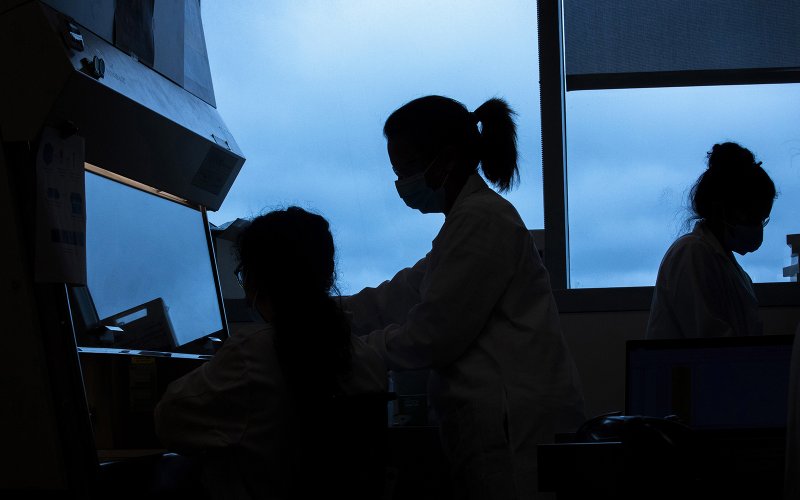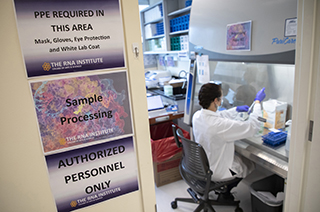The Who, What, Why and How of a Novel Surveillance Testing Program

ALBANY, N.Y. (Sept. 23, 2021) — Since the fall of 2020, the University, led by its RNA Institute, School of Public Health (SPH) and Emergency Management office, has been among higher education’s leaders in having a COVID-19 testing program that is safe, highly accurate and efficient. UAlbany’s COVID Surveillance Testing Program has been keeping its students and employees up-to-the-minute in where they stand in regard to a virus that still afflicts campuses across America.
The background story of the program, which has conducted more than 161,000 tests upon members of the campus community, uncovering 913 positive results to date, is as follows.
Who: The College of Arts & Sciences’ RNA Institute’s COVID surveillance testing team, overseen by Andy Berglund, Institute director, and managed by Tammy Reid, the Institute’s research and development manager, and John Cleary, an Institute collaborative staff scientist. The testing facility team is composed of technicians from the Institute labs of Berglund, Kaalak Reddy and David Halvorsen, as well as outside technicians hired as program assistants.
The testing program — dedicated to keeping UAlbany and the New York’s Capital Region safe during COVID-19 — is run by a team from the three UAlbany entities: the Institute and SPH handle front-end logistics and data analysis, and UAlbany’s Emergency Management commandeers back-end notifications, student/staff interfaces and isolation/quarantines.

This triumvirate works in close contact with UAlbany’s Student Health Services and the Albany County Department of Health, which handles any diagnostically confirmed cases initially identified by the UAlbany surveillance program. The testing facility uses only staff and not graduate students or post-doctoral trainees, so that the Institute retains its focus on the long-term development of RNA as a tool for science and the advancement of human health.
What: UAlbany’s saliva test is a PCR-based assay, based upon the Yale SalivaDirect and the University of Illinois tests, which both directly test saliva for the presence of SARS-CoV-2 viral RNA. Both report a very high accuracy rate — SalivaDirect 94 percent and the Illinois test 99.8-99.9 percent with very few false positives.
“The combination of high specificity combined with frequent testing makes saliva-based testing extremely accurate,” said Berglund.
Additionally, both methods directly test saliva without extensive sample processing, reducing the supply chain burden, and simplifying the testing process.
Why: In the summer of 2020, the RNA Institute, like many academic research institutions, was running with only essential COVID-19 related research and personnel. However, with the upcoming academic school year and growing interest and experience with saliva testing, the Institute explored options to keep the campus community safe and the University open in the first COVID academic school semester.
What was needed was an affordable, easy-to-use, rapid and highly sensitive COVID-19 test that didn’t overwhelm the existing diagnostic testing labs. Berglund had existing experience with COVID-19 research, collaborating with SUNY Upstate Medical University to investigate clusters of COVID-19 patients by sequencing RNA from patients, their microbiome and the SARS-CoV-2 virus. This study helped to understand the genetics and transmission of the virus and, along with the Yale and University of Illinois findings, showed the utility of testing saliva.
Due to the RNA-centric nature of this approach, the Institute was tapped to lead the testing facility portion of the surveillance program. It eventually expanded to testing the entire campus and then external partners.
How: The RNA Institute partnered with SPH to provide pooled surveillance testing to all students and staff on UAlbany’s three campuses as well to as external partners — a simple and non-invasive weekly test using a saliva sample. The process: Scientists group four samples together, add a chemical solution, and perform a sensitive PCR-based assay to determine if SARS-CoV-2 viral RNA is present in the pooled samples. The pools are broken down to individual samples and retested to identify the presumed positive individuals.
While the UAlbany program uses the same principles and processes as diagnostic PCR testing, its testing facility is not certified by the regulatory agency overseeing diagnostic labs and so cannot be used for any medical reason. All presumptive positive individuals identified by the surveillance program must undergo a confirmatory diagnostic test.
Through Tuesday, the UAlbany Surveillance Program had conducted 161,132 tests — about 5,600 done this fall — revealing 913 positives for the virus. The program has conducted nearly 30,000 additional tests upon people from external partners such as SEFCU and Siena College, bringing the total of tests conducted by the RNA Institute to more than 190,000.




